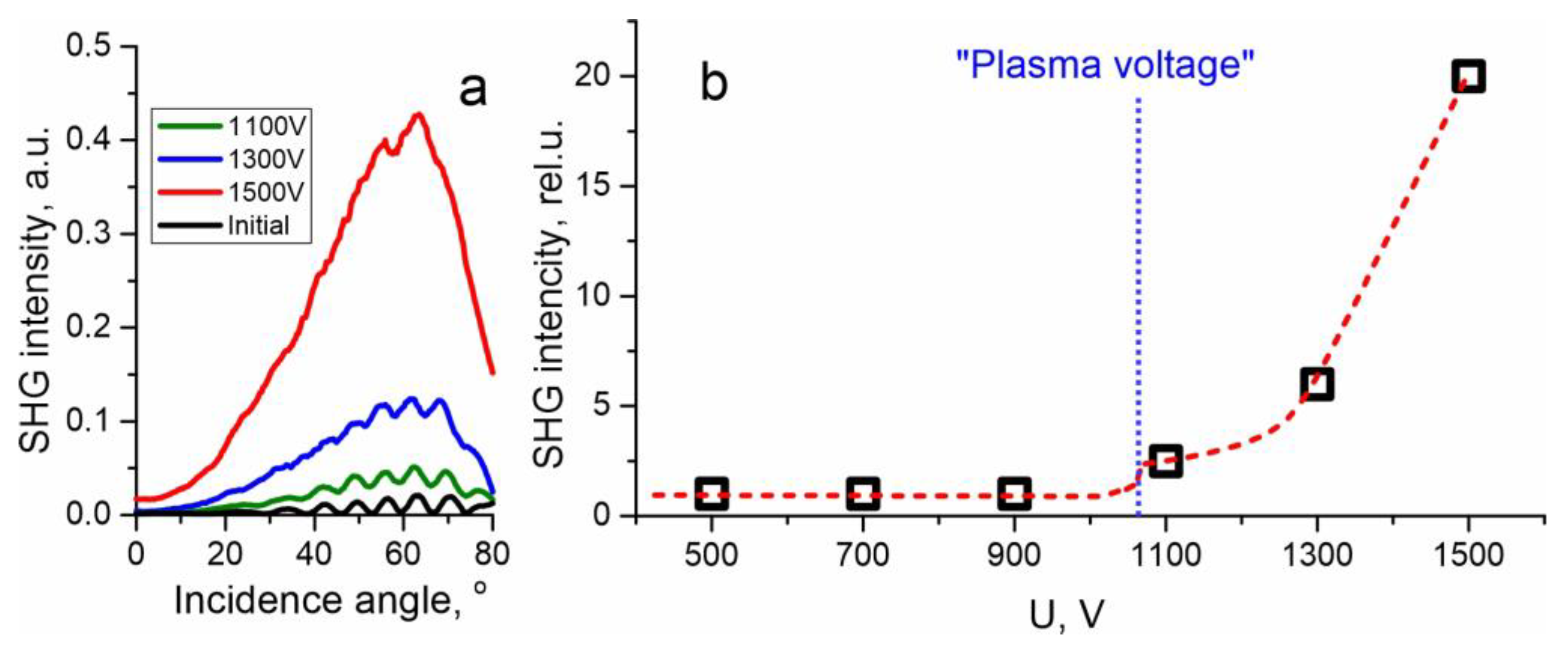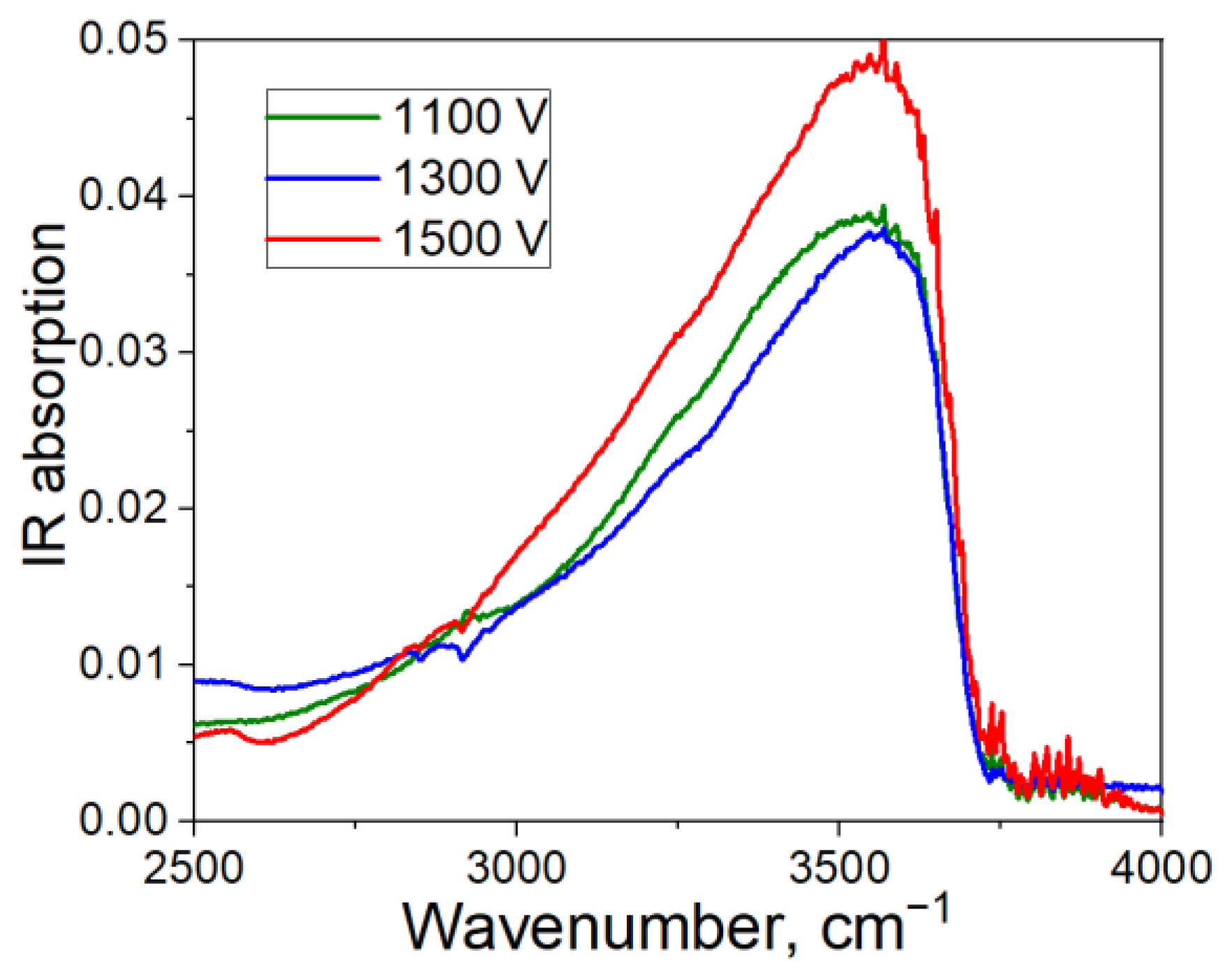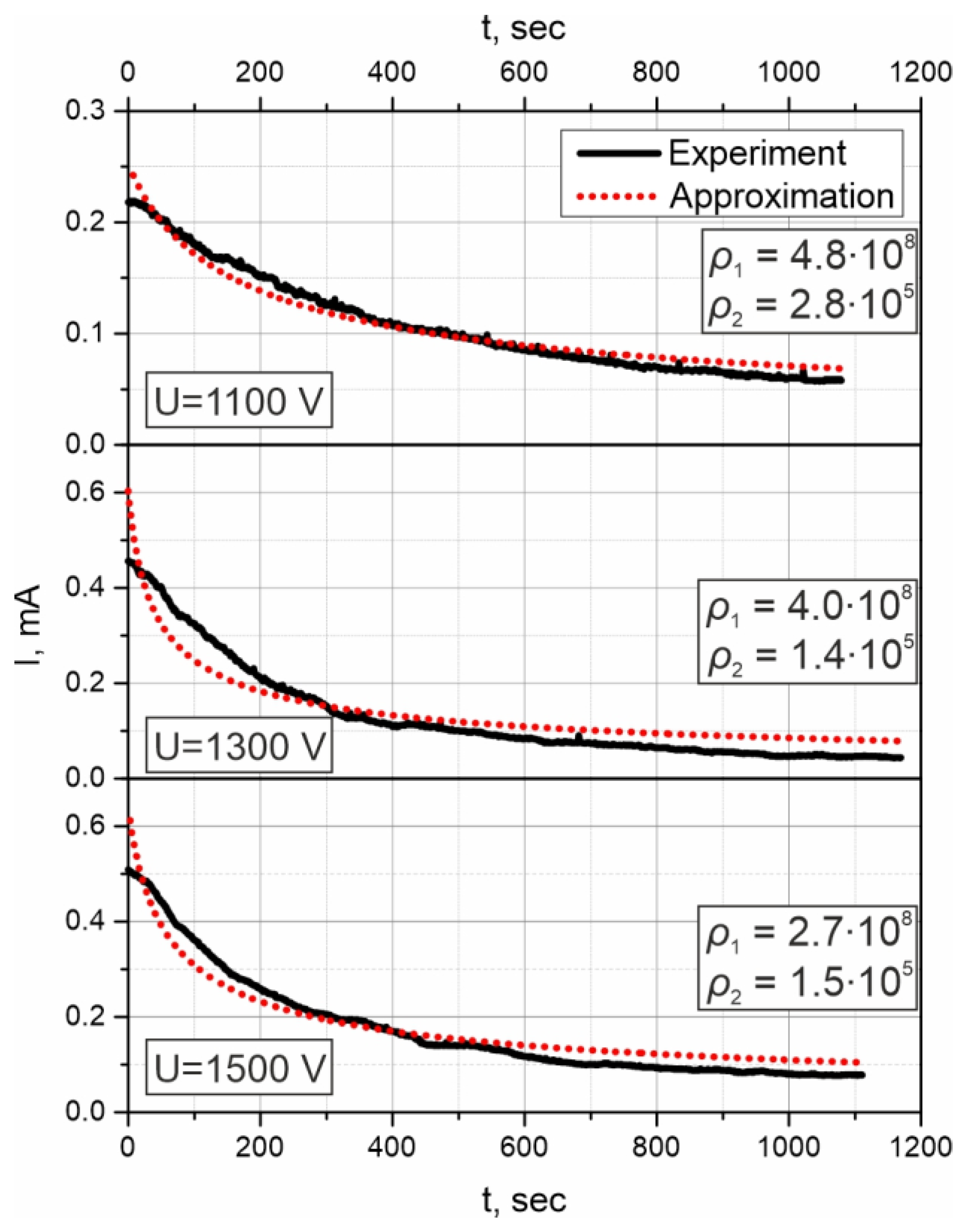Poling of Glasses Using Resistive Barrier Discharge Plasma
Abstract
1. Introduction
2. Materials and Methods
3. Results and Discussion
3.1. Experimental
3.2. Modeling
4. Conclusions
Author Contributions
Funding
Acknowledgments
Conflicts of Interest
References
- Mednikova, E.I.; Sharnopol’skaya, E.T. Glass electrets. Glass Ceram. 1963, 20, 190–192. [Google Scholar] [CrossRef]
- Sessler, G.M. (Ed.) Electrets; Topics in Applied Physics; Springer: Berlin/Heidelberg, Germany, 1987; Volume 33, ISBN 978-3-540-17335-9. [Google Scholar] [CrossRef]
- Le Calvez, A.; Freysz, E.; Ducasse, A. A model for second harmonic generation in poled glasses. Eur. Phys. J. D-At. Mol. Opt. Phys. 1998, 1, 223–226. [Google Scholar] [CrossRef]
- Petrov, M.I.; Lepen’kin, Y.A.; Lipovskii, A.A. Polarization of glass containing fast and slow ions. J. Appl. Phys. 2012, 112, 043101. [Google Scholar] [CrossRef]
- An, H.; Fleming, S. Second-order optical nonlinearity and accompanying near-surface structural modifications in thermally poled soda-lime silicate glasses. J. Opt. Soc. Am. B 2006, 23, 2303. [Google Scholar] [CrossRef]
- Alley, T.G.; Brueck, S.R.J.; Wiedenbeck, M. Secondary ion mass spectrometry study of space-charge formation in thermally poled fused silica. J. Appl. Phys. 1999, 86, 6634–6640. [Google Scholar] [CrossRef]
- Yang, G.; Cao, J.; Qi, Y.; He, X.; Peng, C.; Lu, Y.; Tang, F.; Tang, K.; Liu, B.; Chen, H.; et al. Imprinting gradient refractive index micro-structure in GeS2–Ga2S3–KCl glass for broadband diffraction grating. Opt. Mater. 2020, 101, 109766. [Google Scholar] [CrossRef]
- Kubo, N.; Ikutame, N.; Takei, M.; Weibai, B.; Ikeda, S.; Yamamoto, K.; Uraji, K.; Misawa, T.; Fujioka, M.; Kaiju, H.; et al. Nano-imprinting of surface relief gratings on soda-aluminosilicate and soda-lime silicate glasses. Opt. Mater. Express 2017, 7, 1438. [Google Scholar] [CrossRef]
- Kamenskii, A.N.; Reduto, I.V.; Petrikov, V.D.; Lipovskii, A.A. Effective diffraction gratings via acidic etching of thermally poled glass. Opt. Mater. 2016, 62, 250–254. [Google Scholar] [CrossRef]
- Chervinskii, S.; Sevriuk, V.; Reduto, I.; Lipovskii, A. Formation and 2D-patterning of silver nanoisland film using thermal poling and out-diffusion from glass. J. Appl. Phys. 2013, 114, 224301. [Google Scholar] [CrossRef]
- Lubyankina, E.A.; Raskhodchikov, D.V.; Babich, E.S.; Kaasik, V.P.; Lipovskii, A.A. Peculiarities of ion-exchange in poled glasses. J. Phys. Conf. Ser. 2021, 2086, 012152. [Google Scholar] [CrossRef]
- Dussauze, M.; Cremoux, T.; Adamietz, F.; Rodriguez, V.; Fargin, E.; Yang, G.; Cardinal, T. Thermal Poling of Optical Glasses: Mechanisms and Second-Order Optical Properties. Int. J. Appl. Glass Sci. 2012, 3, 309–320. [Google Scholar] [CrossRef]
- Reshetov, I.; Scherbak, S.; Tagantsev, D.; Zhurikhina, V.; Lipovskii, A. Giant Enhancement of Optical Second Harmonic in Poled Glasses by Cold Repoling. J. Phys. Chem. Lett. 2022, 13, 5932–5937. [Google Scholar] [CrossRef] [PubMed]
- Dussauze, M.; Rodriguez, V.; Lipovskii, A.; Petrov, M.; Smith, C.; Richardson, K.; Cardinal, T.; Fargin, E.; Kamitsos, E.I. How does thermal poling affect the structure of soda-lime glass? J. Phys. Chem. C 2010, 114, 12754–12759. [Google Scholar] [CrossRef]
- Luo, J.; Bae, S.; Yuan, M.; Schneider, E.; Lanagan, M.T.; Pantano, C.G.; Kim, S.H. Chemical structure and mechanical properties of soda lime silica glass surfaces treated by thermal poling in inert and reactive ambient gases. J. Am. Ceram. Soc. 2018, 101, 2951–2964. [Google Scholar] [CrossRef]
- Cremoux, T.; Dussauze, M.; Fargin, E.; Cardinal, T.; Talaga, D.; Adamietz, F.; Rodriguez, V. Trapped molecular and ionic species in poled borosilicate glasses: Toward a rationalized description of thermal poling in glasses. J. Phys. Chem. C 2014, 118, 3716–3723. [Google Scholar] [CrossRef]
- Okada, A.; Ishii, K.; Mito, K.; Sasaki, K. Second-order optical nonlinearity in corona-poled glass films. J. Appl. Phys. 1993, 74, 531–535. [Google Scholar] [CrossRef]
- Sato, N.; Sekimoto, K.; Takayama, M. Ionization Capabilities of Hydronium Ions and High Electric Fields Produced by Atmospheric Pressure Corona Discharge. Mass Spectrom. 2017, 5, S0067. [Google Scholar] [CrossRef]
- Brandenburg, R. Dielectric barrier discharges: Progress on plasma sources and on the understanding of regimes and single filaments. Plasma Sources Sci. Technol. 2017, 26, 053001. [Google Scholar] [CrossRef]
- Agar Scientific. Available online: http://www.agarscientific.com/microscope-slides.html (accessed on 3 November 2022).
- Babich, E.; Kaasik, V.; Lipovskii, A. Kinetics of Nanoparticles Formation Under UV, VIS and IR Nanosecond Laser Irradiation of a Silver-Ions-Enriched Glass. J. Laser Micro/Nanoeng. 2021, 16, 88–95. [Google Scholar] [CrossRef]
- An, H.; Fleming, S. Second-order optical nonlinearity in thermally poled borosilicate glass. Appl. Phys. Lett. 2006, 89, 181111. [Google Scholar] [CrossRef]
- Moura, A.L.; Nascimento, E.M.; Araujo, M.T.; Vermelho, M.V.D.; Aitchison, J.S. Voltage thresholdlike evidence during thermal-electric field induction of second order nonlinearity in soda-lime glasses. J. Appl. Phys. 2009, 105, 036106. [Google Scholar] [CrossRef]
- Goillot, A.; Maillard, A.; Galstian, T.; Messaddeq, Y.; Adamietz, F.; Rodriguez, V.; Dussauze, M. Plasma assisted micro poling of glassy surfaces: A new tool to achieve liquid crystal multi-domain alignments [Invited]. Opt. Mater. Express 2022, 12, 2462. [Google Scholar] [CrossRef]
- Machala, Z.; Laux, C.O.; Kruger, C.H.; Candler, G.V. Atmospheric air and nitrogen DC glow discharges with thermionic cathodes and swirl flow. In Proceedings of the 42nd AIAA Aerospace Sciences Meeting and Exhibit, Reno, NV, USA, 5–8 January 2004; pp. 3285–3300. [Google Scholar] [CrossRef]
- Reshetov, I.; Kaasik, V.; Kan, G.; Shestakov, S.; Scherbak, S.; Zhurikhina, V.; Lipovskii, A. SHG in Micron-Scale Layers of Glasses: Electron Beam Irradiation vs. Thermal Poling. Photonics 2022, 9, 733. [Google Scholar] [CrossRef]
- Jerphagnon, J.; Kurtz, S.K. Maker Fringes: A Detailed Comparison of Theory and Experiment for Isotropic and Uniaxial Crystals. J. Appl. Phys. 1970, 41, 1667–1681. [Google Scholar] [CrossRef]
- Wang, X.; Shen, S.; Sun, J.; Fan, F.; Chang, S. Surface and bulk second-harmonic responses from a glass slide using tightly focused radially polarized light. Opt. Lett. 2016, 41, 5652. [Google Scholar] [CrossRef]
- Ercilbengoa, A.E.; Loiseau, J.F.; Spyrou, N. Current and light waveforms associated with the dark- to glow-discharge transition in medium- and low-pressure point-to-plane gaps. J. Phys. D Appl. Phys. 2000, 33, 2425–2433. [Google Scholar] [CrossRef]
- Scherbak, S.A.; Kaasik, V.P.; Zhurikhina, V.V.; Lipovskii, A.A. SEM-visualization of a spatial charge and a giant potassium peak in a corona-poled glass. J. Phys. Condens. Matter 2021, 33, 235702. [Google Scholar] [CrossRef]
- Tong, A.S.K.; Bondu, F.; Senthil Murugan, G.; Wilkinson, J.S.; Dussauze, M. Effect of sodium addition and thermal annealing on second-order optical nonlinearity in thermally poled amorphous Ta2O5 thin films. J. Appl. Phys. 2019, 125, 015104. [Google Scholar] [CrossRef]
- Redkov, A.V.; Melehin, V.G.; Lipovskii, A.A. How Does Thermal Poling Produce Interstitial Molecular Oxygen in Silicate Glasses? J. Phys. Chem. C 2015, 119, 17298–17307. [Google Scholar] [CrossRef]
- Oven, R. Analytical model of electric field assisted ion diffusion into glass containing two indigenous mobile species, with application to poling. J. Non-Cryst. Solids 2021, 553, 120476. [Google Scholar] [CrossRef]
- Lin, Y.T.; Smith, N.J.; Banerjee, J.; Agnello, G.; Manley, R.G.; Walczak, W.J.; Kim, S.H. Water adsorption on silica and calcium-boroaluminosilicate glass surfaces—Thickness and hydrogen bonding of water layer. J. Am. Ceram. Soc. 2021, 104, 1568–1580. [Google Scholar] [CrossRef]
- Prieto, X.; Liñares, J. Increasing resistivity effects in field-assisted ion exchange for planar optical waveguide fabrication. Opt. Lett. 1996, 21, 1363. [Google Scholar] [CrossRef] [PubMed]
- Redkov, A.; Kaasik, V.; Melehin, V.; Lipovskii, A. Modification of soda-lime silicate glass under corona poling in air and nitrogen atmosphere. J. Non-Cryst. Solids 2021, 554, 120599. [Google Scholar] [CrossRef]
- Mehrer, H.; Imre, A.W.; Tanguep-Nijokep, E. Diffusion and ionic conduction in oxide glasses. J. Phys. Conf. Ser. 2008, 106, 012001. [Google Scholar] [CrossRef]
- Cooper, A.R. The Haven Ratio in Terms of the Self-Diffusion of Charge. In Transport in Nonstoichiometric Compounds; Simkovich, G., Stubican, V.S., Eds.; Springer US: Boston, MA, USA, 1985; pp. 127–137. [Google Scholar]
- Mehrer, H. Diffusion and Ion Conduction in Cation-Conducting Oxide Glasses. Diffus. Found. 2016, 6, 59–106. [Google Scholar] [CrossRef]
- Doremus, R.H. Mechanism of electrical polarization of silica glass. Appl. Phys. Lett. 2005, 87, 1–2. [Google Scholar] [CrossRef]






Publisher’s Note: MDPI stays neutral with regard to jurisdictional claims in published maps and institutional affiliations. |
© 2022 by the authors. Licensee MDPI, Basel, Switzerland. This article is an open access article distributed under the terms and conditions of the Creative Commons Attribution (CC BY) license (https://creativecommons.org/licenses/by/4.0/).
Share and Cite
Scherbak, S.A.; Kaasik, V.P.; Zhurikhina, V.V.; Lipovskii, A.A. Poling of Glasses Using Resistive Barrier Discharge Plasma. Materials 2022, 15, 8620. https://doi.org/10.3390/ma15238620
Scherbak SA, Kaasik VP, Zhurikhina VV, Lipovskii AA. Poling of Glasses Using Resistive Barrier Discharge Plasma. Materials. 2022; 15(23):8620. https://doi.org/10.3390/ma15238620
Chicago/Turabian StyleScherbak, Sergey A., Vladimir P. Kaasik, Valentina V. Zhurikhina, and Andrey A. Lipovskii. 2022. "Poling of Glasses Using Resistive Barrier Discharge Plasma" Materials 15, no. 23: 8620. https://doi.org/10.3390/ma15238620
APA StyleScherbak, S. A., Kaasik, V. P., Zhurikhina, V. V., & Lipovskii, A. A. (2022). Poling of Glasses Using Resistive Barrier Discharge Plasma. Materials, 15(23), 8620. https://doi.org/10.3390/ma15238620





